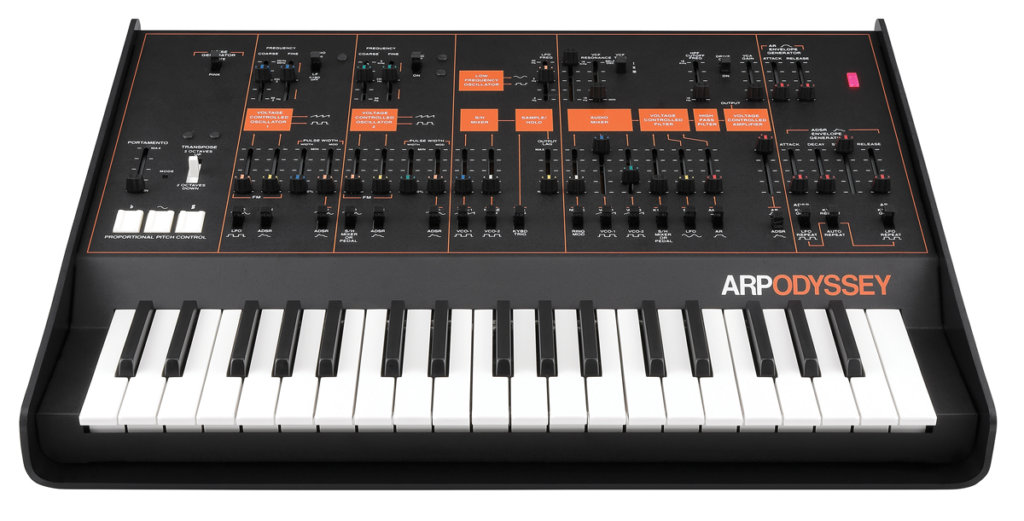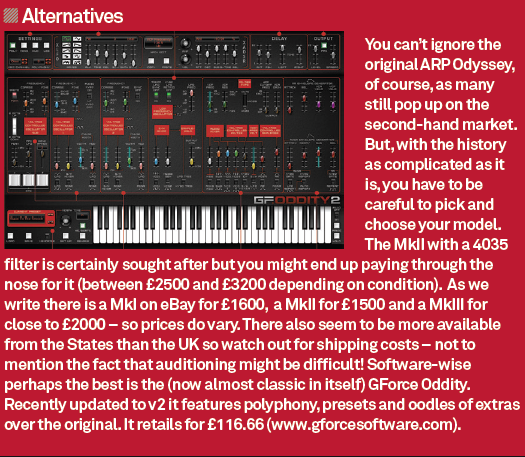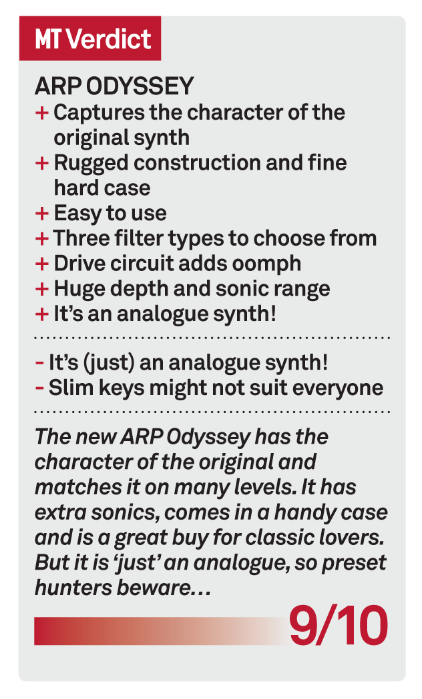Korg ARP Odyssey – The Massive Review: Page 3
Andy Jones concludes his review of the Korg ARP Odyssey… The MkIII was the most widely sold version of the Odyssey back in the day, and the main one that Korg is selling with the other two only available in limited numbers.The (Rather Annoying) History of the ARP Odyssey… It would be easy – not […]

Andy Jones concludes his review of the Korg ARP Odyssey…

It would be easy – not to mention lazy – to look back at the history of the Odyssey and say it came out in three distinct versions, with different colours, as re-imagined with this new model(s) on test. So the MkI was white, MkII was black and gold, and a MkIII orange and black.
Easy, right? Annoyingly it isn’t that easy as there were crossover periods and more model numbers than versions (if that makes sense). The Mk I Odyssey came out in 1972 (model 2800) and was essentially a compact version of the ARP 2600 modular and released as a cut-price, compact synth to compete with the Minimoog. With a white fascia, the filter was a 2-pole voltage controlled model.
In 1974 the colour changed – so some Mk1 models are black and gold rather than white, like we say, just to confuse things. The actual version number only went up to MkII with the arrival of model number 2810 (to 2815). The MkII also had a new filter (a 4035 4-pole VCF,) although a few really early MkIIs boast the Mk1 filter! (Confused? Yes!)

This filter changed to a 4075 after a small but apparently amicable ‘discussion’ with Moog, although the 4035 remains the more sought after MkII model as the 4075 exhibits a weaker sound at a higher resonance. The MkIII came out between 1978 and 81 (model numbers 2820 to 2823) and retained this filter although had a sturdier chassis and familiar orange and black colour scheme.
In total then, the Odyssey was in production for less than a decade but left a mark like few other synths. It was used in a vast number of genres – not just the electronic sounds so beloved by this author – and everyone from ABBA to Chick Corea, from Elton John to Herbie Hancock became fans.
Thanks to VintageSynth.com for filling in some gaps in our history…
Sounds – Capturing the Spirit
So, new features aside, how does the new ARP measure up to the original? There’s no doubting that it does capture many of the original’s quirks and idiosyncrasies. It is, on most occasions, definitely an Odyssey. Bass sounds capture that Autobahn moment, while soaring and buzzy leads proffer the best in Numan strings. Compared to the original it can fall very slightly down in terms of depth as often the classic has a presence that the new one just occasionally fails to reach.
However you’d be hard pressed to tell the difference unless you put one next to the other – which, fortunately, we got to do by way of GForce software’s Dave Spiers. This is the man whose love of the original led to him developing the Oddity, the most well regarded software version of the Odyssey. He has compared all three with the new synth and says…
“My main point is that each of the originals were calibrated differently and will often sound different – even between the same model number. So it’s almost pointless comparing like with like, but I have made some rough approximations between both and got some very close results – you won’t hear differences in the mix.
“A key sound is the sync sweep lead and here again I got some really close results. Another key thing is that with duophonic mode, the original has some very distinct ways of triggering notes as you play them.
“Using duophonic mode in conjunction with the ring modulator is a thing of joy. Tune each of the VCOs an octave apart, add a slight detune and then push the ring mod slider up and drop back the VCO1 and two sliders. Playing single notes sounds aggressive but then adding a second note gives you ring mod distorted bliss. However, on the original the harmonic intervals are a lot more ‘in-tune’ with your root note whereas this new version doesn’t quite hit the same intervals.

It can still tear your head off though, and it certainly captures the essence and the aggressive character which was the big difference between the Moog and the ARP. Billy Currie (Ultravox, Visage) called the Odyssey, ‘the first punk synth’, and this new synth has definitely got that snarl.
“And what I also love about the new one is that it’s small, light and it’s sexy. People might whinge about the slim keys but it has MIDI and USB. If you were to retrofit an original ARP to do this it would probably cost an extra £500 alone!” ”
So what do we think?
The new ARP does a good job. It’s not 100% perfect and I’d like to say I could hear the difference side-by-side with an original, maybe six times out of 10. But it certainly captures the spirit of the original. You’ll be able to create that character with ease, and in isolation you’ll be very happy with the results.

For the money, it represents a serious amount of sound and hardware. It’s enough like the original to make anyone who lacks long pockets sit up and take notice. However there is a caveat to anyone else. Don’t just buy it because you’ve heard the ARP Odyssey was (and is) an awesome synth; try out the original or the many software versions first (for which the GForce Oddity v2 is as good a start as any).
The reason I note this caution is because, at the end of the day, this is simply an analogue synth which comes with restrictions that go with the territory. It lacks great polyphony and presets so it’s not going to set your inspiration on fire as much as the do-it-all ‘digital’ soft synths you might already have (or the Moog Sub 37 analogue that you should want).
But this is as close to a synth that featured on more classic electronic tracks than most.
It’s also a sturdy piece of hardware that you can interact with more than any software and come up with some great classic, analogue sounds. The case is cool, you can choose the colour (for a time) and it’s compact and playable. We’d certainly recommend it to those after the original experience on a budget and to those who want to audition one of the greatest synths on a smaller scale. The start of many remakes?

